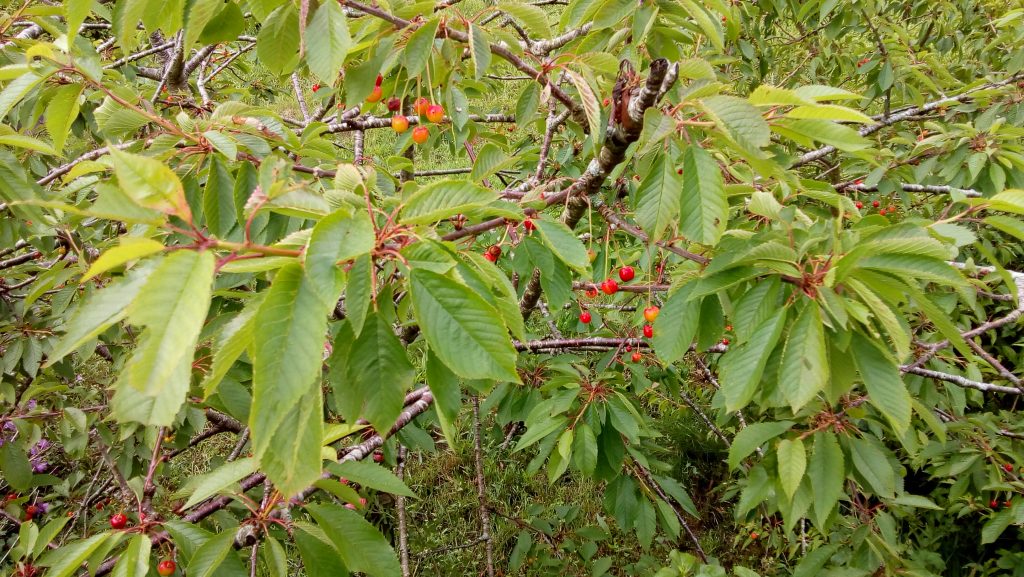My debut novel is called “The Mazzard Tree” and I suspect that not many people outside of North Devon will know what a mazzard is. I thought I’d let you all in on the secret.
The mazzard or gean is a domesticated form of wild cherry (prunus avium). In years gone by they were widely grown in North Devon, particularly in the villages of Landkey, Swimbridge, and Goodleigh where the trees thrived upon the slopes of the Taw valley in the damp, mild climate.

Up until the end of World War 1 there were over 100 acres of mazzards recorded in my home village of Landkey alone. They were dotted all over the valley, predominantly in the Venn area. Most farmers had a mazzard green of two or three acres, including my father who farmed at Hill Farm in Venn. As a child I can remember the beautiful frothy pink and white blossom in the spring. This was was followed in July by an abundance of luscious black and red fruits. Birds are partial to mazzards and they can strip an orchard in a few days. As the mazzards ripened children scared the birds with rattles and farmers kept watch with rifles to protect their crops.
Mazzard trees grow very tall and farmers made long ladders to reach the top. Women from the village were employed to pick the mazzards into baskets. The baskets were hung on the branches with metal hooks to leave both hands free for picking. The five different strains of mazzard are the Dun, Greenstem Black, Black Bottler, Small Black and Hannaford. There were also three varieties of apple indigenous to Landkey, the Stockbearer, Limberland and Listener, but I do not know if any of these have survived. Another species of fruit tree that was special to Landkey was the Landkey Yellow. This was a type of plum and commonly used in hedges.
The mazzards were taken to the Pannier Market in Barnstaple and sold by the pound. It is said that in 1645 the future King Charles 11 sampled mazzard pie when he stayed with the Countess of Bath at Tawstock. Mazzards are gently cooked and served with Devonshire clotted cream or made into tarts or pies. I remember my mother bottling them for use during the winter when fruit was scarce. They are also delicious eaten straight from the tree, often leaving tell-tale purple stains around the mouths of children.
As the 20th century progressed mazzards fell out of fashion due to the substantial amount of labour required to protect and harvest the crop. The trend after 1918 was for populations to move away from rural areas in search of better paid jobs in towns and this made labour for mazzard picking too expensive.
When my father gave up farming in 1975 due to ill health, the council farm his family had occupied for more than half a century was taken over. The trees in the beautiful mazzard green I had loved as a child were ripped up. Underground pipes were laid to drain the water from the gently meandering brook to make the land more amenable for crops. In doing this a natural waterfall and a quaint little bridge were lost forever.
Fortunately there is a happy ending to this tale about mazzards. In the 1970s, Dick Joy, a Landkey man and long-serving Chairman of the Parish Council, persuaded a local nurseryman to start growing mazzard trees. These trees found their way into gardens in the village and the mazzard tree was saved albeit in a very small way.
In the late 1990s, local leaders learnt of plans to build a substantial housing development on the green fields in the centre of the village. Fearing the detrimental effect that a building project of such magnitude would have on the character of the village, the Parish Council, under the leadership of Dick Joy, began a relentless campaign to persuade the builders to abandon their plans.
The Parish Council’s campaign eventually took them to Westminster where the government ruled that the planned development should not go ahead. No small achievement as I’m sure many would agree. There was much relief when the land which now forms the Millennium Green was donated to the Parish Council to be used as a recreational facility for the village.
With the year 2000 approaching, the newly-created Landkey Millennium Trust applied for National Lottery money and was successfully awarded £35,000. In 1999, children in the village helped to plant 65 sapling trees and so a new mazzard green was created. The Millennium Green is now a much loved and well used facility in the centre of the village.
My first book is based in the 1880s in a rural village in North Devon. A mazzard green is an important place for two of the characters to meet and so I decided that “The Mazzard Tree” would be a good title and maybe continue to promote this lovely fruit tree.
0 Comments